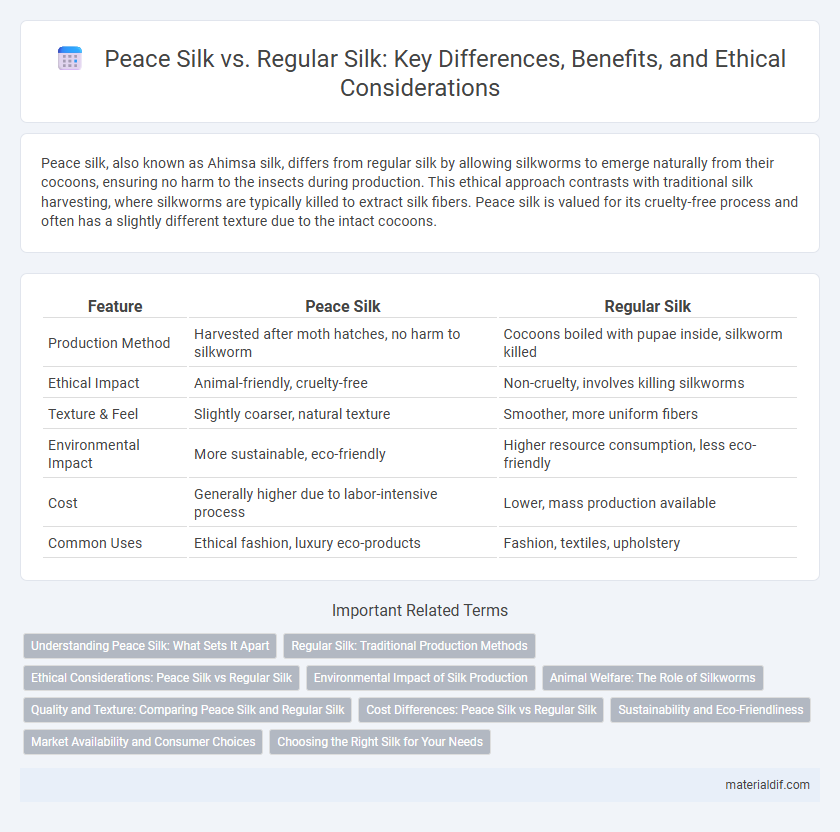Peace silk, also known as Ahimsa silk, differs from regular silk by allowing silkworms to emerge naturally from their cocoons, ensuring no harm to the insects during production. This ethical approach contrasts with traditional silk harvesting, where silkworms are typically killed to extract silk fibers. Peace silk is valued for its cruelty-free process and often has a slightly different texture due to the intact cocoons.
Table of Comparison
| Feature | Peace Silk | Regular Silk |
|---|---|---|
| Production Method | Harvested after moth hatches, no harm to silkworm | Cocoons boiled with pupae inside, silkworm killed |
| Ethical Impact | Animal-friendly, cruelty-free | Non-cruelty, involves killing silkworms |
| Texture & Feel | Slightly coarser, natural texture | Smoother, more uniform fibers |
| Environmental Impact | More sustainable, eco-friendly | Higher resource consumption, less eco-friendly |
| Cost | Generally higher due to labor-intensive process | Lower, mass production available |
| Common Uses | Ethical fashion, luxury eco-products | Fashion, textiles, upholstery |
Understanding Peace Silk: What Sets It Apart
Peace Silk differs from regular silk by allowing silkworms to complete their natural life cycle before harvesting, avoiding the conventional process of boiling cocoons with larvae inside. This ethical approach ensures no harm to silkworms, promoting sustainability and animal welfare. The resulting fiber from Peace Silk is often softer and eco-friendlier, appealing to conscious consumers seeking cruelty-free textiles.
Regular Silk: Traditional Production Methods
Regular silk production relies on traditional sericulture, where silkworms are cultivated on mulberry leaves and harvested by boiling cocoons, a process that kills the pupae inside. This method ensures continuous filament quality but raises ethical concerns due to the destruction of silkworms. The industrial scale of regular silk production prioritizes high yield and uniform fiber strength, widely used in luxury textiles and fashion industries.
Ethical Considerations: Peace Silk vs Regular Silk
Peace silk, also known as Ahimsa silk, is produced without killing silkworms, preserving their life cycle and aligning with ethical and cruelty-free values. Regular silk involves boiling silkworms alive to extract the silk fibers, raising significant animal welfare concerns. Choosing peace silk supports sustainable and humane practices, appealing to consumers prioritizing ethical fashion.
Environmental Impact of Silk Production
Peace silk, also known as Ahimsa silk, minimizes environmental harm by allowing silkworms to complete their life cycle, promoting biodiversity and reducing waste compared to regular silk production which involves boiling cocoons with larvae inside. The traditional method of regular silk production demands significant water and energy resources, contributing to higher carbon emissions and habitat disruption. Peace silk's eco-friendly approach supports sustainable agriculture practices and reduces chemical pesticide reliance, making it a greener alternative in the textile industry.
Animal Welfare: The Role of Silkworms
Peace silk, also known as Ahimsa silk, prioritizes animal welfare by allowing silkworms to complete their natural lifecycle and emerge from their cocoons before silk extraction, minimizing harm to the insects. In contrast, regular silk production typically involves boiling silkworm cocoons while the larvae are still inside, resulting in the death of the silkworms. This ethical approach in peace silk supports sustainable and cruelty-free silk farming practices.
Quality and Texture: Comparing Peace Silk and Regular Silk
Peace Silk, also known as Ahimsa silk, offers a softer texture and more natural sheen compared to regular silk due to its non-violent harvesting process that allows silkworms to mature and exit the cocoon. Regular silk, harvested by boiling silkworms alive, often results in a smoother but less textured fabric with a slightly glossy finish. The quality of Peace Silk is characterized by its breathable, eco-friendly properties and subtle irregularities that enhance its unique tactile appeal.
Cost Differences: Peace Silk vs Regular Silk
Peace silk, also known as Ahimsa silk, typically costs more than regular silk due to its ethical production methods that allow silkworms to complete their life cycle without harm. The labor-intensive process and lower yield contribute to higher prices compared to conventional silk, which involves boiling silkworms and produces larger quantities more quickly. Consumers interested in cruelty-free and sustainable fabrics often accept the premium price of peace silk despite the cost difference.
Sustainability and Eco-Friendliness
Peace silk, also known as Ahimsa silk, is produced without harming silkworms, making it a more sustainable and eco-friendly alternative to regular silk, which involves boiling silkworms alive to extract the fibers. The production of peace silk reduces environmental impact by promoting natural lifecycle completion and often incorporates organic farming practices that minimize pesticide use. Regular silk production tends to have a higher carbon footprint and ethical concerns, while peace silk supports biodiversity and animal welfare, aligning with sustainable fashion principles.
Market Availability and Consumer Choices
Peace silk, also known as Ahimsa silk, is gaining market availability through niche eco-friendly and ethical fashion brands that prioritize cruelty-free production methods. Regular silk dominates mainstream markets due to established supply chains and lower production costs, appealing to a broad range of consumers seeking affordability and traditional quality. Growing consumer preference for sustainable and humane products drives increased demand and accessibility for peace silk in luxury and conscious consumer segments.
Choosing the Right Silk for Your Needs
Peace silk, also known as Ahimsa silk, is produced without killing the silkworms, making it an ethical and cruelty-free alternative to regular silk. Regular silk, harvested by boiling the cocoons with the larvae inside, tends to have a smoother texture and a more lustrous finish but raises animal welfare concerns. Choosing the right silk depends on your priorities: select Peace silk for a sustainable, eco-friendly option or regular silk for traditional silk's sheen and softness.
Peace Silk vs Regular Silk Infographic

 materialdif.com
materialdif.com